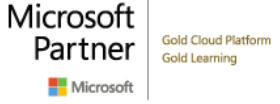Description
- Date: April 12 – 16, 2021| 9:00 AM – 8:00 PM EST–12 Seats Left Register, Early to secure class
- Date: April 26 – 30, 2021| 10:00 AM – 9:00 PM EST–15 Seats Left Register, Early to secure class
- Date: May 03 – o7, 2021 | 8:00 AM – 7:00 PM EST—12 Seats Left Register, Early to secure class
- Date: May 17 – 21, 2021| 10:00 AM – 9:00 PM EST–15 Seats Left Register, Early to secure class
- Date: June 07 – 11, 2021 | 8:00 AM – 7:00 PM EST—12 Seats Left Register, Early to secure class
These class dates receive $400.00 Discount for registrations completed before 03/20/21
- Delivery Format: Virtual Classroom Live
- Location: ONLINE
Dates are not a fit? Ask about Private Lead Classes for your company teams, with 6 or more employees.
Course AZ-303T00-A: Microsoft Azure Architect Technologies
Module 1: Implement VMs for Windows and Linux In this module, you will learn about Azure virtual machines including planning, creating, availability and extensions. This module includes: Lessons- Select Virtual Machine Size
- Configure High Availability
- Implement Azure Dedicated Hosts
- Deploy and Configure Scale Sets
- Configure Azure Disk Encryption
- Plan for virtual machine implementations.
- Create virtual machines.
- Configure virtual machine availability, including scale sets.
- Understand High Availability options for VMs in Azure
- Azure Resource Manager Templates
- Save a Template for a VM
- Evaluate Location of New Resources
- Configure a Virtual Hard Disk Template
- Deploy from a Template
- Create and Execute an Automation Runbook
- Leverage Azure Resource Manager to organize resources.
- Use ARM Templates to deploy resources.
- Create and Execute an Automation Runbook
- Deploy an Azure VM from a VHD
- Understand Azure encryption technologies
- Virtual Network Peering
- Implement VNet Peering
- Connect services with Virtual Network Peering
- Configure VNet Peering
- Understand Service Chaining
- Modify or delete VNet Peering
- Implement Azure Load Balancer
- Implement an Application Gateway
- Understand Web Application Firewall
- Implement Azure Firewall
- Implement Azure Front Door
- Implementing Azure Traffice Manager
- Implement Network Security Groups and Application Security Grou
- Implement Azure Bastion
- Select a Load Balancer solution
- Configure Application Gateway
- Implement Azure Firewall
- Create an Azure Front Door
- Understand Traffic Manager routing methods
- Configure Network Security Groups (NSGs)
- Storage Accounts
- Blob Storage
- Storage Security
- Managing Storage
- Accessing Blobs and Queues using AAD
- Configure Azure Storage Firewalls and Virtual Networks
- Understand Storage Account services and types
- Configure Blob storage, accounts, containers, and access tiers
- Implement Shared Access Signatures
- Understand Azure Storage firewalls and virtual networks
- Overview of Azure Active Directory
- Users and Groups
- Domains and Custom Domains
- Azure AD Identity Protection
- Implement Conditional Access
- Configure Fraud Alerts for MFA
- Implement Bypass Options
- Configure Trusted IPs
- Configure Guest Users in Azure AD
- Manage Multiple Directori
- Understand how Multiple AAD organizations interact
- Add Guest Users to Azure AD
- Configure Location Condition Configuration
- Configure Azure MFA settings
- Implement Conditional Access Azure MFA
- Create Management Groups, Subscriptions, and Resource Groups
- Overview of Role-Based Access Control (RBAC)
- Role-Based Access Control (RBAC) Roles
- Azure AD Access Reviews
- Implement and Configure an Azure Policy
- Azure Blueprints
- Understand Resource Group 0rganization
- Understand how RBAC works
- Create an Azure AD access review
- Create and manage policies to enforce compliance
- Create a Blueprint
- Install and Configure Azure AD Connect
- Configure Password Sync and Password Writeback
- Configure Azure AD Connect Health
- Implement Azure AD seamless Single Sign-On
- Perform an Azure AD Connect installation
- Implement Azure AD Connect Health
- Migrate Workloads using Azure Migrate
- VMware – Agentless Migration
- VMware – Agent-Based Migration
- Implement Azure Backup
- Azure to Azure Site Recovery
- Implement Azure Update Management
- Understand agent-based migration architecture
- Prepare for Azure for migration
- Prepare an on-premises VMware environment
- Understand Azure VM backup architecture
- Manage updates and patches for Azure VMs
- Azure Infrastructure Security Monitoring
- Azure Monitor
- Azure Workbooks
- Azure Alerts
- Log Analytics
- Network Watcher
- Azure Service Health
- Monitor Azure Costs
- Azure Application Insights
- Unified Monitoring in Azure
- Azure Key Vault
- Azure Managed Identity
- After completing this module, students will be able to:
- Explain Key Vault uses such as screts, key, and Cerficate management
- Use Managed Identities with Azure resources
- Create and Configure Azure App Service
- Create an App Service Web App for Containers
- Create and Configure an App Service Plan
- Configure Networking for an App Service
- Create and Manage Deployment Slots
- Implement Logic Apps
- Implement Azure Functions
- Configure an Azure App Service
- Create an App Service Plan
- Create a Workflow using Azure Logic Apps
- Create a Function App
- Azure Container Instances
- Configure Azure Kubernetes Service
- After completing this module, students will be able to:
- Run Azure Container instances
- Deploy Kubernetes with AKS
- Configure Storage Account Tables
- Select Appropriate CosmosDB APIs
- Outline the Table Service Data Model
- Understand options for Azure Cosmos DB
- Understand high availability using CosmosDB
- Configure Azure SQL Database Settings
- Implement Azure SQL Database Managed Instances
- High-Availability and Azure SQL Database
- Create an Azure SQL Database single database
- Create an Azure SQL Database Managed Instance
- Recommend high-availability architectural models used in Azure SQL Database
Course AZ-304T00-A: Microsoft Azure Architect Design
Module 1: Design for Cost Optimization In this module, you will learn how to optimize costs from recommendations, breakdown costs by Azure Service, and download and review usage details. 01-View Lessons- Recommend Solutions for Cost Management
- Recommended Viewpoints for Minimizing Costs
- Optimize with Azure Cost Management.
- Design with Cost in mind
- Optimize Costs from recommendations
- Azure Monitoring Services
- Azure Monitor
- Monitor Azure resources with Azure Monitor
- Collect and analyze Resource Logs for Azure resources
- Understand how Azure Sentinel collects data on the devices, users, infrastructure, and applications
- Recommend a Solution for Multi-Factor Authentication
- Recommend a Solution for Single-Sign On (SSO)
- Five Steps for Securing Identity Infrastructure
- Recommend a Solution for a Hybrid Identity
- Recommend a Solution for B2B Integration
- Plan for a MFA Deployment
- Understand Azure Active Directory Seamless Single Sign-On (SSO)
- Recommend an Authentication Methodology for Hybrid Identity
- Integrate with Identity Providers
- Infrastructure Protection
- Recommend a Hierarchical Structure for Management Groups, Subscriptions and Resource Groups
- Recommend hierarchy of Management Groups and Subscriptions.
- Configure custom RBAC Role definitions and assignments
- Recommend a Solution for using Azure Policy
- Recommend a Solution for using Azure Blueprint
- Organize Policies with Initiatives
- Manage Tag Governance with Azure Policy
- Provide guidance on Azure Blueprints
- Recommend a Solution using KeyVault
- Recommend a Solution using Azure AD Managed Identities
- Understand Key Vault authentication and authorization
- Understand Azure Key Vault availability and redundancy
- Understand how Blueprints differ from Resource Manager Templates and Azure Policy
- Select an Appropriate Data Platform Based on Requirements
- Overview of Azure Data Storage
- Recommend Database Service Tier Sizing
- Dynamically Scale Azure SQL Database and Azure SQL Managed Instances
- Recommend a Solution for Encrypting Data at Rest, Transmission, and In Use
- Recommend Database Service Tier Sizing
- Recommend a Solution for Encrypting Data at Rest, Transmission, and In Use
- Understand Azure Data Lake Store and Azure Blob Storage containers
- Recommend a Data Flow
- Recommend a Solution for Data Integration
- Implement Azure Synapse Analytics
- Describe how data flows using Azure Data Factory
- Demonstrate how to use Azure Data Factory to load data into SQL Data Warehouse
- Understanding Storage Tiers
- Recommend a Storage Access Solution
- Recommend Storage Management Tools
- Recommend tools for working with Azure Storage
- Design for Azure Blob Storage access tiers
- Recommend a Recovery Solution for Hybrid and On-Premises Workloads
- Design and Azure Site Recovery Solution
- Recommend a Solution for Recovery in Different Regions
- Recommend a Solution for Azure Backup Management
- Design a Solution for Data Archiving and Retention
- Recommend solutions for Azure hybrid and on-premises workloads that meets recovery objectives
- Recommend a solution for site recovery capacity
- Recommend storage types and methodology for data archiving
- Identify requirements for data archiving
- Recommend a Solution for Application and Workload Redundancy
- Recommend a Solution for Autoscaling
- Identify Resources that Require High Availability
- Identify Storage Tpes for High Availability
- Recommend a Solution for Geo-Redundancy of Workloads
- Recommend a solutions for autoscaling
- Identify storage types for high availability
- Recommend a solutions for geo-redundancy of workloads
- Recommend a Solution for Compute Provisioning
- Determine Appropriate Compute Technologies
- Recommend a Solution for Containers
- Recommend a Solution for Automating Compute Management
- Refer solution for automating compute management
- Recommend the appropriate compute technologies, including virtual machines, and App Services
- Recommend the approriate AKS and ACI and the configurations
- Recommend a Solution for Network Addressing and Name Resolution
- Recommend a Solution for Network Provisioning
- Recommend a Solution for Network Security
- Recommend a Solution for iInternete Connectivity and On-Premises Networks,
- Recommend a Solution for Automating Network Management
- Recommend a Solution for Load Balancing and Rraffic Routing
- Solutions for network addressing and name resolution
- Solutions for network security including private endpoints, firewalls, and gateways
- Recommendations for network connectivity to the Internet, on-premises networks, and other VNets.
- Recommendations for load balancing and traffic routing
- Recommend a Microservices Architecture
- Recommend an Orchestration Solution for Deployment of Applications
- Recommend a Solution for API Integration
- Recommend deployment solutions using ARM templates, Logic Apps, or Azure Functions
- Recommend a solution for monitoring automation
- Recommend a hosting structure for API management
- Assess and On-Premises Servers and Applications for Migration
- Recommend a Solution for Migrating Applications and VMs
- Recommend a Solution for Migration of Databases
- Assess on-premises servers and applications for migration
- Suggest solutions for migrating applications and VMs
- Determine migration scope, including redundant, related, trivial, and outdated data





